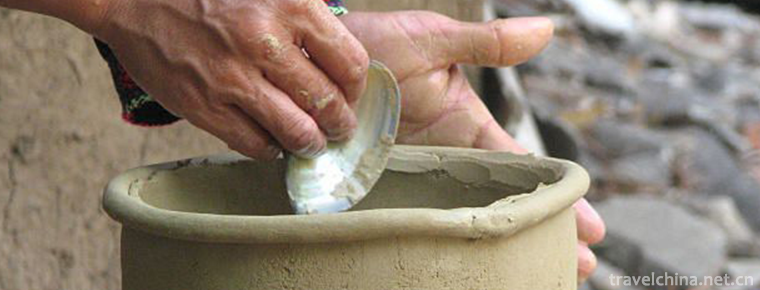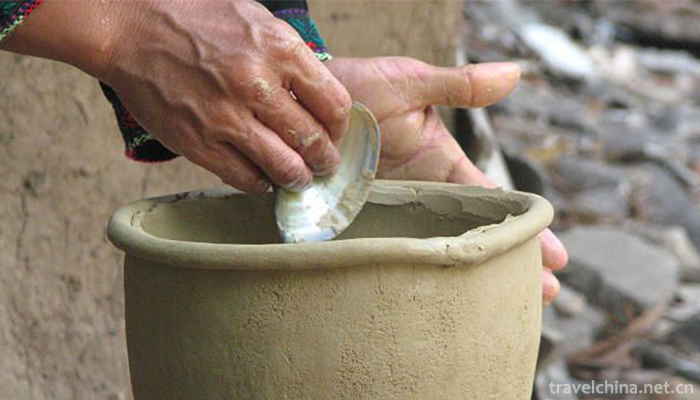2019-01-16

- By ChinaWiki.net
- Chinese Edition
- 2019-05-13
Primitive Pottery Making Skills of Li Nationality
The primitive pottery making technique of Li nationality, the traditional handicraft technique of Changjiang Li Autonomous County, Hainan Province, is one of the national intangible cultural heritages.
The primitive pottery-making techniques of the Li nationality have a long history. The primitive pottery-making techniques of the Li nationality appeared in Hainan six or seven years ago before archaeological discovery. After the Eastern Han Dynasty, the primitive pottery-making techniques of the Li nationality were recorded in the history books.
historical origin
The pottery-making technology of Li nationality, discovered from archaeology, should exist in the prehistoric pottery-making history. Archaeologists have found pottery with geometric prints in Sanya and Lingshui. Its history can be traced back to the Neolithic Age.
The emergence of Chinese pottery has a history of about 10,000 years. In Hainan, according to archaeological excavation materials, Hainan's pottery has a history of at least 6,000 years. Documents also contain relevant records. In the history books after the Eastern Han Dynasty, the activities of Li's ancestors (Li people) in Hainan have been recorded. Pottery making had already been spread to Hainan Island at that time. The Song Dynasty's Zhubo Zhi recorded that Li people "used earth as kettle and ladle as utensil", and so far the earthen kettle has been used between ladles. Ma Duanlin, Yuan Dynasty, recorded in the General Examination of Documents: "The pottery is the kettle and the pottery is the ladle for utensils". The Qing Dynasty Daoguang's "Qiongzhou Prefecture chronicle. Haili chronicle 5" states: "earthen kettle for utensils, ladles." It can be seen that the primitive pottery of Li nationality has been handed down from generation to generation. Gu Yanwu of the Qing Dynasty also recorded Li people in the Book of Diseases in the Country of the Prefecture under Heaven: "Xuan Ji wooden cloth, pottery is the kettle."
In The Li Nationality of Hainan Island, the modern German anthropologist Stubo made a special description of the Li Nationality's pottery: "Using opaque grey-black clay to make simple pottery, such as wine urns, pots, casseroles, plates, etc.
Process characteristics
The shape and appearance of Li pottery are proportionate, with appropriate thickness, primitive simplicity, dignified and thick, compact structure, smooth surface, no sand, cracks and holes. Impurities and other accessories, red, black, grey, brown, purple and other colors, earthenware on the natural formation of a variety of fantastic, freehand brushwork patterns and patterns, intriguing, with a strong ornamental.
Inheritance and protection
Inheritance value
The primitive pottery-making techniques such as clay bar and tray method are still inherited in Dapo area of Shilu Town, Changjiang Li Autonomous County, Hainan Island, which has an important enlightenment for the study of prehistoric pottery history. The Li nationality retains the original form and characteristics of pottery making and truly reproduces the original process of pottery making, which is the "living fossil" of ancient Chinese pottery making.
Inheritance status
With the development of society, the improvement of living standards and the convergence of social culture, porcelain, glassware, metal ware, plastic ware and other substitutes for pottery have entered daily life, and the production of Li ceramics has gradually shrunk, especially during the "Cultural Revolution", almost all production has been stopped. There are few Li artists who know how to make pottery now. The pottery making technology is on the verge of extinction. It is urgent to take effective measures to ensure its transmission.
Inheriting characters
Yang Bailiang, female, Han nationality, born in November 1935, is a native of Baotu Village, Shilu Town, Changjiang Li Autonomous County, Hainan Province. Yang Bailiang studied pottery making with his mother in his childhood. In decades of practice, Yang Bailiang's pottery making skills were very mature. With clay men as materials, he created pottery using simple tools such as wooden poles, wood white, cypress, wood scrapers and bamboo knives, clam shells, drilled bamboo sticks, and bamboo mats. The types of utensils became more and more diverse. Li's pottery making skills have always been "handed down to women but not to men". In the past, women did not even allow outsiders or men to watch when making pottery. The so-called "female pottery men do not approach". Yang Bailiang passed all his skills to his daughter Huang Yuying and granddaughter-in-law Wen Afen. In June 2007, Yang Bailiang was selected as the representative successor of the first batch of national intangible cultural heritage projects and declared in Changjiang Li Autonomous County, Hainan Province.
protective measures
In 2008, Sanya organized relevant personnel to conduct extensive and in-depth field investigation on the primitive pottery making skills of the Li people. By means of writing, recording, photography, video and other multimedia means, the primitive pottery making skills of the Li people and their pottery articles were comprehensively and systematically recorded, and relevant materials were excavated and sorted out, archives and databases were established.
On March 21, 2012, Sanya intangible cultural heritage protection center was officially set up. Since then, special funds have been allocated every year to support its conservation and inheritance, holding Li Tao skills training courses, and establishing Li Tao seminars and Exhibition halls. Publishing a large picture album of Tianya Earthpottery Art, filming a documentary of "Li Nationality's Primitive Ceramic Art" and collating relevant literary materials.
social influence
Domestic influence
More and more hotels, hotels and well-known large enterprises have come to buy "Li Tao" as a display of Arts and crafts or as a gift to guests. Nearly 10 well-known Chinese enterprises have come to discuss acquisition or cooperative development.
Important exhibition
On December 12, 2015, the China (Hainan) International Tropical Agricultural Winter Fair was held in Hainan International Convention and Exhibition Center. The primitive pottery making skills of Li nationality were displayed.
On April 18, 2018, one of the key activities of the Changjiang Branch of Hainan "March 3" was held at the Li Pottery Experience Hall of Baotu Village. The primitive pottery making skills of the Li people were displayed.

Ask a Question
Your email address will not be published.



0 Questions